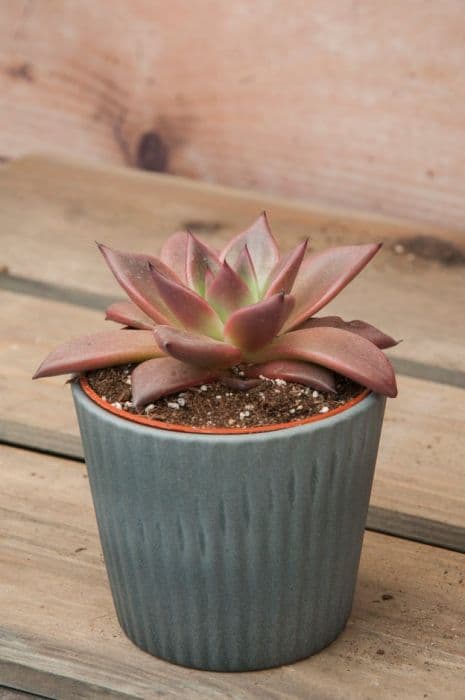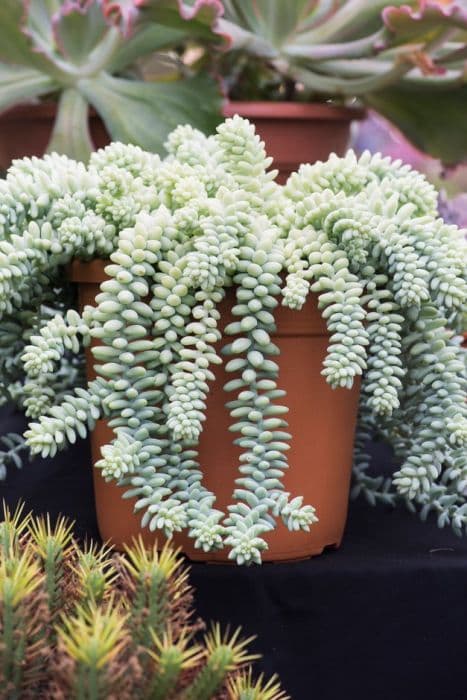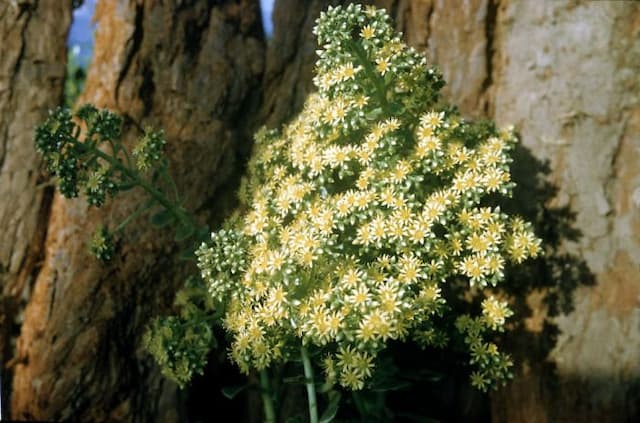Penwiper Plant Kalanchoe marmorata
















ABOUT
Kalanchoe marmorata, commonly referred to as Penwiper Plant, is a succulent known for its striking appearance. It has a robust and fleshy countenance, characterized by broad, flat leaves that are a deep green with distinctive purple or brownish blotches or spots that resemble ink stains—hence the name "Penwiper." These marks of color add to its ornamental value and give it a marbled effect, which can vary from leaf to leaf. The leaves of the Penwiper Plant are arranged in a rosette form, contributing to its full and lush arrangement. The edges of the leaves are often undulating, which may add a sense of texture and depth to the overall appearance of the foliage. Over time, the plant may produce clusters of small, tubular flowers that burst forth in a striking display of color contrast against the muted tones of the mottled foliage. These flowers can come in various shades, adding to the visual interest of the plant. Kalanchoe marmorata's waxy and thick leaves are a classic trait of many succulents, helping it to retain water and thrive in environments that are less forgiving to other types of plants. It's a plant that's not only admired for its unique leaf patterns but also appreciated for its resilience and relatively easy care. The overall aesthetic of the Penwiper Plant makes it a desirable choice for those seeking a hardy yet beautiful addition to their collection of houseplants or garden succulents.
About this plant
 Names
NamesFamily
Crassulaceae.
Synonyms
Penwiper Plant, Spotted Kalanchoe.
Common names
Bryophyllum marmoratum, Kalanchoe marmorata, Bryophyllum marmoratum.
 Toxicity
ToxicityTo humans
Penwiper plant (Kalanchoe marmorata) contains chemical compounds that can be toxic to humans if ingested. Although it is generally not considered highly poisonous to humans, consuming parts of this succulent can potentially lead to vomiting, diarrhea, and in rare cases, abnormal heart rhythms due to the presence of cardiac glycosides. It is essential to be cautious and keep this plant out of reach of children who might accidentally ingest it.
To pets
The Penwiper plant is toxic to pets such as cats and dogs. If a pet ingests parts of the plant, it can experience symptoms like vomiting, diarrhea, excessive drooling, and changes in heart rate or rhythm. This is due to compounds in the plant, specifically cardiac glycosides, which can seriously affect the cardiovascular system. In severe cases, ingestion can lead to life-threatening conditions, and immediate veterinary attention is needed if poisoning is suspected.
 Characteristics
CharacteristicsLife cycle
Perennials
Foliage type
Evergreen
Color of leaves
Green
Flower color
Pink
Height
1-2 feet (30-60 cm)
Spread
1-2 feet (30-60 cm)
Plant type
Succulent
Hardiness zones
10
Native area
Madagascar
Benefits
 General Benefits
General Benefits- Low Maintenance: Kalanchoe marmorata is relatively easy to care for, requiring minimal watering and can tolerate periods of neglect.
- Drought Tolerant: Due to its succulent nature, it has the ability to store water and endure dry conditions for quite some time.
- Ideal for Indoor Gardening: It can thrive indoors with adequate light, making it suitable for those with limited outdoor space.
- Aesthetic Appeal: With its distinctive green and purple mottled leaves, it adds a decorative touch to any space.
- Long Blooming Period: The plant produces long-lasting flowers which can bring color to an indoor environment over several months.
- Easy to Propagate: It can be easily propagated from leaf cuttings, making it simple to increase your collection or share with others.
 Medical Properties
Medical Properties- Wound Healing: Kalanchoe marmorata is traditionally used in some cultures for its purported ability to aid in the healing of minor wounds.
- Anti-inflammatory: Compounds found in the plant are believed to have anti-inflammatory properties, which may help reduce swelling and pain in certain conditions.
- Antimicrobial: The plant has been used in folk medicine for its antimicrobial effects, particularly in preventing or reducing infection in cuts and abrasions.
 Air-purifying Qualities
Air-purifying QualitiesThis plant is not specifically known for air purifying qualities.
 Other Uses
Other Uses- Ornamental Display: Kalanchoe marmorata can be used to create a focal point in rock gardens or terrarium arrangements due to its spotted, textured leaves and compact growth habit.
- Educational Tool: This plant is ideal for teaching about CAM (Crassulacean Acid Metabolism) photosynthesis, a water-conserving process used by succulents.
- Photography Subject: Because of its unique marbled leaves, Kalanchoe marmorata is a popular subject for photographers specializing in botanical imagery.
- Artistic Inspiration: Artists may use the intricate patterns of this plant's leaves as inspiration for designs in painting, textiles, or other visual arts.
- Feng Shui: Some practitioners of Feng Shui may place Kalanchoe marmorata in certain areas of a home to promote positive energy.
- Craft Projects: The thick leaves of Kalanchoe marmorata can be used in various craft projects, such as making leaf prints or incorporating them into handmade paper.
- Miniature Setting: The small size and distinct appearance of the plant make it suitable for miniature gardens or fairy gardens.
- Culinary Garnish: Although not typically consumed, the non-toxic leaves may serve as an unusual garnish for plating in high-end culinary presentations.
- Seasonal Decor: During winter months, Kalanchoe marmorata can add a touch of greenery to holiday décor, especially when combined with red accents.
- Bioindicators: In a controlled environment, the plant can be used to study the effects of varying light conditions on succulent plant growth and pigmentation.
Interesting Facts
 Feng Shui
Feng ShuiThe Kalanchoe is not used in Feng Shui practice.
 Zodiac Sign Compitability
Zodiac Sign CompitabilityThe Kalanchoe is not used in astrology practice.
 Plant Symbolism
Plant Symbolism- Endurance: Kalanchoe plants, known for their ability to withstand harsh conditions and neglect, symbolize persistence and resilience.
- Persistence: They have thick leaves that store water, allowing them to persist even in challenging environments, representing tenacity in adversity.
- Healing: Kalanchoe marmorata, commonly called Penwiper Plant, is often associated with healing because of its medicinal properties in some cultures, symbolizing recovery and rejuvenating qualities.
- Longevity: The plant's ability to produce new shoots and propagate easily gives it a symbol of longevity and continuous growth.
- Prosperity: In some traditions, the robust nature of the Penwiper Plant is equated with wealth and the growth of prosperity.
 Water
WaterPenwiper plants require moderate watering, allowing the soil to dry out between waterings. Typically, watering once every 1-2 weeks should be sufficient, adjusting for climate and indoor conditions. When watering, aim to provide about 16 ounces of water for smaller pots, and up to a gallon for larger containers, ensuring even soil moisture without waterlogging. During the winter months, reduce watering frequency as plant growth slows.
 Light
LightPenwiper plants thrive in bright, indirect light but can tolerate some direct sunlight. A spot near an east or south-facing window that receives plenty of light without the harsh afternoon sun is ideal. Avoid placing your Penwiper in low light conditions, which can lead to leggy growth and reduced vitality.
 Temperature
TemperaturePenwipers prefer temperatures between 60 and 85 degrees Fahrenheit and can tolerate a minimum of around 50 degrees Fahrenheit. They should be protected from frost and sudden drops in temperature. The ideal conditions are room temperature, around 65 to 75 degrees Fahrenheit, avoiding cold drafts and extreme heat.
 Pruning
PruningPrune Penwiper plants to remove dead or yellowing leaves and to maintain a compact, attractive shape. Pruning is best done in the spring or early summer when the plant is entering a period of active growth. Every 2 to 3 months, check for leggy stems or overgrowth and prune as necessary.
 Cleaning
CleaningAs needed
 Soil
SoilPenwiper Plant prefers a well-draining cactus or succulent mix, with a pH between 6.0 and 7.5. Mix equal parts of potting soil, coarse sand, and perlite or pumice for optimal growth.
 Repotting
RepottingPenwiper Plants should be repotted every two to three years or when the plant has outgrown its pot to encourage healthy growth and rejuvenate the nutrient supply of the soil.
 Humidity & Misting
Humidity & MistingPenwiper Plants thrive best in low to average humidity levels, similar to their native arid habitats; they do not require high humidity.
 Suitable locations
Suitable locationsIndoor
Ensure bright light, limited water, and well-draining soil for indoor Penwiper Plants.
Outdoor
Place in sun to partial shade, protect from heavy rain, use well-draining soil for outdoor Penwiper.
Hardiness zone
9-11 USDA
 Life cycle
Life cycleKalanchoe marmorata, commonly known as Penwiper Plant, begins its life cycle as a seed, germinating in warm, well-draining soil with indirect light. Upon germination, it produces small rosettes of leaves that gradually develop the species' characteristic mottled patterns. As a juvenile, the plant continues to grow by forming more leaves and increasing in size, eventually reaching maturity and flowering, often during late winter or spring. After pollination, typically through insect vectors, flowers give way to seed capsules containing tiny seeds, which are then dispersed, beginning a new generational cycle. Penwiper Plant is also capable of vegetative reproduction; leaf cuttings or offsets can root and grow into individual plants, thereby cloning the parent. Throughout its life, Kalanchoe marmorata requires minimal water and is adapted to survive periods of drought, which is characteristic of its succulent nature.
 Propogation
PropogationPropogation time
Spring-Summer
For the Kalanchoe marmorata, often referred to as Penwiper Plant, the most popular method of propagation is through leaf cuttings. This is typically done in spring or summer when the plant is in its active growth phase. To propagate, a healthy leaf is selected and gently twisted off the stem, ensuring a clean break. The leaf cutting should then be allowed to dry for a few days in a warm environment to allow the cut end to callous over, preventing rot when planted. After the callous forms, the leaf is planted callous-end down in well-draining soil, barely covering the cut end with the soil mixture. It should be kept in bright, indirect light and watered sparingly until roots develop, usually within 2 to 3 weeks. Once rooted, the new plant can be treated as an adult Kalanchoe marmorata.








![Takeshima stonecrop [Atlantis]](/_next/image?url=https%3A%2F%2Fplants-admin.emdemapps.com%2Fimages%2Fplants%2F%2Fimages%2F604b5470cdde2.png&w=640&q=75)
